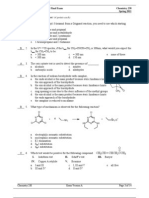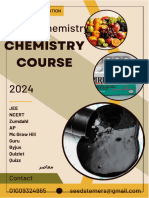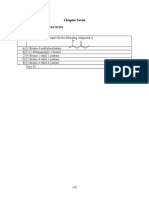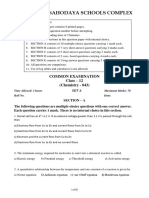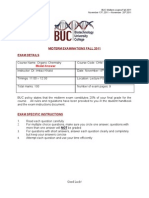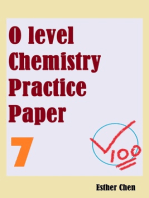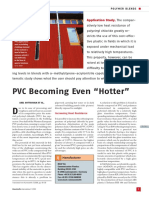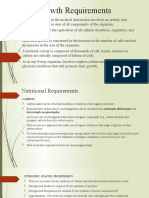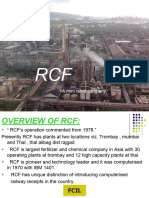CHEM 1315 Exam 4 Practice C
CHEM 1315 Exam 4 Practice C
Uploaded by
mikamundkurCopyright:
Available Formats
CHEM 1315 Exam 4 Practice C
CHEM 1315 Exam 4 Practice C
Uploaded by
mikamundkurOriginal Description:
Original Title
Copyright
Available Formats
Share this document
Did you find this document useful?
Is this content inappropriate?
Copyright:
Available Formats
CHEM 1315 Exam 4 Practice C
CHEM 1315 Exam 4 Practice C
Uploaded by
mikamundkurCopyright:
Available Formats
CHEM 1315 Exam 4 Practice c
Name:______________________ Roll Number ________________
1. (40 points, 4 points each) Circle the correct answer. There is only one correct answer. a. A) B) C) D) E) b. A) B) C) D) E) c. A) B) C) D) E) d. A) B) C) D) E) e. A) B) C) D) E) Which of the following reactions would not give the indicated product? methylbenzoate + ammonia to give benzamide + methanol phenyl acetate + methanol to give methyl acetate + phenol propanamide + methanol to give methyl propanoate + ammonia acetic anhydride + methanol to give methyl acetate + acetic acid acetyl chloride + hydroxide to give acetic acid + chloride Which of the following will result in the formation of a carboxylic acid? Hydrolysis is reaction with water. hydrolysis of an acid anhydride with heat hydrolysis of an acyl halide acid-catalyzed hydrolysis of an amide acid-catalyzed hydrolysis of a nitrile all of the above What happens to the hybridization of the carbonyl carbon upon addition of a nucleophile? It changes from sp3 to sp2. It changes from sp3 to sp. It changes from sp2 to sp3 It changes from sp to sp3. The hybridization does not change. Acetyl chloride undergoes nucleophilic substitution at a faster rate than does methyl acetate because the ester is more sterically hindered than the acyl chloride. the acyl chloride is more sterically hindered than the ester. esters hydrolyze faster than acyl chlorides. chloride ion is a better leaving group than methoxide ion. methoxide ion is a better leaving group than chloride ion. Which of the following reactions can be used to form 3-methyl-3-hexanol? 2-butanone + propylmagnesium bromide followed by addition of H+/H2O 2-pentanone + ethylmagnesium bromide followed by addition of H+/H2O 2-pentanone + methylmagnesium bromide followed by addition of H+/H2O a and b a and c
Page 1 of 7
CHEM 1315 Exam 4 Practice c
Name:______________________ Roll Number ________________
f.
What is the systematic name of the following compound?
O
A) B) C) D) E) g. A) B) C) D) E) h.
4,6,6-trimethyl-3-hexanone 2,4-dimethyl-5-heptanone ethyl isohexyl ketone 4,6-dimethyl-3-heptanone 4-methyl-3-octanone Carbonyl compounds can be reduced to alcohols using sodium borohydride followed by addition of H+/H2O. Which statement best describes the mechanism? addition of a hydrogen radical, followed by addition of a second hydrogen radical addition of a hydride ion, followed by addition of water addition of a hydride ion, followed by addition of a proton addition of a hydride ion and a proton more or less at the same time addition of a proton, followed by addition of a hydride ion What is the main reason that a hydrogen bonded to the alpha carbon adjacent to a carbonyl carbon is more acidic than a hydrogen of an alkane?
A) The carbonyl group is an electron-donating group and weakens the C-H bond in the alpha-position. B) The negative charge is stabilized by its proximity to the negatively charged carbonyl carbon. C) The negative charge is delocalized, and most of the charge resides on the electronegative carbonyl oxygen. D) The negative charge is delocalized, and most of the charge resides on the alpha-carbon. E) The carbonyl group is an electron-withdrawing group and weakens the C-H bond in the alpha-position. i. A) B) C) D) E) Which of the following represents the correct relative acidities for the alpha hydrogens in the compounds listed? -keto esters > ketones > esters > amides -keto esters > ketones > amides > esters amides > esters > -keto esters > ketones ketones > esters > -keto esters > amides esters > -keto esters > ketones > amides
Page 2 of 7
CHEM 1315 Exam 4 Practice c
Name:______________________ Roll Number ________________
j. A) B) C) D) E)
Which of the following compounds is the most acidic? propanenitrile ethyl acetoacetate (CH3COCH2COOCH2CH3) ethyl acetate 2,4-pentanedione Acetone
2. (40 points, 4 points each) SHORT ANSWER. Draw the structure, or write the word or phrase that best completes each statement or answers the question. a. What is the name of the following compound?
b. The pKa of HCl is -7 and the pKa of CH3OH is 15.5. What would you expect the outcome of the reaction of methyl acetate with the chloride ion to be?
c. What is the product of the following reaction?
O O
+
H3C
NH2
Page 3 of 7
CHEM 1315 Exam 4 Practice c
Name:______________________ Roll Number ________________
d. What are the products of the following reaction? Account for all atoms in the products.
e. Which ketone is more reactive 4-methyl-3-hexanone or 5-methyl-3-hexanone? Provide a brief explanation why it is more reactive.
O O
Circle A or B Explanantion:
f. What two reagents are needed to complete the following reaction?
Page 4 of 7
CHEM 1315 Exam 4 Practice c
Name:______________________ Roll Number ________________
g. What is the result of the reaction of sodium borohydride (NaBH4) and methyl propanoate?
h. What product is formed when methyl ethyl ketone (2-butanone) is reacted with excess methanol in the presence of an acid catalyst?
i. How many alpha or enolizable hydrogens are present in the following molecule?
j. What is the Aldol condensation product of the reaction of 2 equivalents of propanal in a base catalyzed reaction followed by heating in acid?
Page 5 of 7
CHEM 1315 Exam 4 Practice c
Name:______________________ Roll Number ________________
3. (10 points) Which is the stronger acid, an amide or an amine? Explain your selection with either a drawing or brief description.
4. (10 points) Provide a step-by-step mechanism for the acid catalyzed formation of the hemiketal from reacting ethanol and cyclohexanone.
Page 6 of 7
CHEM 1315 Exam 4 Practice c
Name:______________________ Roll Number ________________
xxxxxxxxx xxxxxxxxx xxxxxxxxx x
xxxxxxxxx xxxxxxxxx xxxxxxxxx x
Chapter 2 slide 15
Page 7 of 7
You might also like
- Unit 4 KTT 2 Organic Pathways - Question BookDocument10 pagesUnit 4 KTT 2 Organic Pathways - Question BookkaustubhsontyNo ratings yet
- 238 Finial ExamDocument10 pages238 Finial Exammominamin100% (2)
- Johnston Banks, 1990Document57 pagesJohnston Banks, 1990hajaxat617No ratings yet
- Chapter 7Document71 pagesChapter 7cjn999982% (11)
- Chapter 7Document56 pagesChapter 7itsjc0% (1)
- Chapter 5: Structure and Preparation of Alkenes - Elimination ReactionsDocument13 pagesChapter 5: Structure and Preparation of Alkenes - Elimination ReactionsRahma AshrafNo ratings yet
- O Level Biology Practice Questions And Answers EnzymesFrom EverandO Level Biology Practice Questions And Answers EnzymesRating: 5 out of 5 stars5/5 (1)
- HWDocument1 pageHWMelissa Suelto0% (1)
- Oil Mist Lubrication TrainingDocument70 pagesOil Mist Lubrication TrainingDelfinsh100% (5)
- 4.2.2. Volumetric SolutionsDocument5 pages4.2.2. Volumetric SolutionsMohamed Dahmane100% (2)
- CHEM 1315 Exam 4 Practice A1Document7 pagesCHEM 1315 Exam 4 Practice A1mikamundkurNo ratings yet
- CHEM 1315 Exam 4 Practice BDocument6 pagesCHEM 1315 Exam 4 Practice BmikamundkurNo ratings yet
- Houston Community College System: Organic Chemistry II 2425Document19 pagesHouston Community College System: Organic Chemistry II 2425Banele Ezma LambathaNo ratings yet
- Chemistry G12Document10 pagesChemistry G12fikerdereje697No ratings yet
- Exam 2 CHM 235 Spring 2012 KEYDocument9 pagesExam 2 CHM 235 Spring 2012 KEYRaquel RenéNo ratings yet
- CHEM 1315 Exam 3 Practice BDocument6 pagesCHEM 1315 Exam 3 Practice BmikamundkurNo ratings yet
- Practice Orgo ExamDocument7 pagesPractice Orgo ExamDoris GrimaldiNo ratings yet
- Complete Download of General Organic and Biochemistry 8th Edition Denniston Test Bank Full Chapters in PDF DOCXDocument43 pagesComplete Download of General Organic and Biochemistry 8th Edition Denniston Test Bank Full Chapters in PDF DOCXhwemdimenth100% (2)
- Set 2Document6 pagesSet 2sanjith4arisNo ratings yet
- 2423 e 3Document21 pages2423 e 3Abdel Rahman MohamedNo ratings yet
- XII Chemistry Sample Question Paper - FinalDocument65 pagesXII Chemistry Sample Question Paper - Finalkrishnapradhani091No ratings yet
- 2423 e 2Document24 pages2423 e 2Agustin KurniatiNo ratings yet
- Organic Chemistry Testbank Dr. Baya Education G11, G12Document209 pagesOrganic Chemistry Testbank Dr. Baya Education G11, G12مطبعة الأقصي100% (1)
- CH 7Document71 pagesCH 7Moira Mochie C. BasilioNo ratings yet
- Chapter 11 Practice QuestionsDocument23 pagesChapter 11 Practice Questionskamophasha789No ratings yet
- 1220+Final+Practice+Exam+ (v2) +for+studentsDocument15 pages1220+Final+Practice+Exam+ (v2) +for+studentskayleeann03No ratings yet
- Sample Paper, XII, 2023-24, PDFDocument8 pagesSample Paper, XII, 2023-24, PDFfareehafatima18No ratings yet
- Question PAPERDocument6 pagesQuestion PAPERharsh.mahori09No ratings yet
- Chemistry SET C QPDocument9 pagesChemistry SET C QPowenknight3456No ratings yet
- Download full Principles of General Organic and Biological Chemistry 2nd Edition Smith Test Bank all chaptersDocument48 pagesDownload full Principles of General Organic and Biological Chemistry 2nd Edition Smith Test Bank all chapterslamevwahbi100% (6)
- 2320PracticeTest3 (Chapter12)Document5 pages2320PracticeTest3 (Chapter12)Mohammad TomaraeiNo ratings yet
- Chemistry Sample Paper 2Document6 pagesChemistry Sample Paper 2Koushiki Chakraborty 10 f 27No ratings yet
- SCH4 Organic Unit TestDocument6 pagesSCH4 Organic Unit TestMariiam CiiNo ratings yet
- Alcohols, Phenols & Ethers QPDocument3 pagesAlcohols, Phenols & Ethers QPIniya RajasekharNo ratings yet
- Moon - Exam 2 - Summer 2011Document10 pagesMoon - Exam 2 - Summer 2011Andres Pena100% (2)
- Organic Chemistry Test Bank (Part 1)Document33 pagesOrganic Chemistry Test Bank (Part 1)sunydayformeNo ratings yet
- gr12practice_exam_11-1Document9 pagesgr12practice_exam_11-1zzzerrooo31No ratings yet
- Gr12practice Exam 11Document9 pagesGr12practice Exam 11zzzerrooo31No ratings yet
- 12th class chemistry paperDocument6 pages12th class chemistry papersandeepgautamNo ratings yet
- Gr12practice Exam 11Document9 pagesGr12practice Exam 11clarisse carcaoNo ratings yet
- 12th class chemistry paperDocument6 pages12th class chemistry papersandeepgautamNo ratings yet
- GAPS 12th Chemistry PreboardDocument11 pagesGAPS 12th Chemistry PreboardvijaysuriNo ratings yet
- CH 14Document28 pagesCH 14ffffffff dfdfdfNo ratings yet
- Alcohols Phenols and Ethers RevsionDocument4 pagesAlcohols Phenols and Ethers RevsionAryan GuptaNo ratings yet
- Chem PreboardDocument13 pagesChem Preboardvirender.pinghalNo ratings yet
- May 2024 SCH4U Final Exam BCSS PDFDocument6 pagesMay 2024 SCH4U Final Exam BCSS PDFleafyfun100No ratings yet
- CH 07Document174 pagesCH 07KyleBernalÜNo ratings yet
- Chapter 09Document15 pagesChapter 09Sara NameerNo ratings yet
- Chemistry SET A QPDocument8 pagesChemistry SET A QPdahaka7609No ratings yet
- Qoii0708 CO 17 TIFDocument34 pagesQoii0708 CO 17 TIFLovely Joysweet100% (2)
- Practice 4ADocument22 pagesPractice 4ACamha NguyenNo ratings yet
- Chemistry 3e Bruice Beard Test BankDocument55 pagesChemistry 3e Bruice Beard Test BanksapiqesteyNo ratings yet
- Unit 4 Industrial ChemistryDocument23 pagesUnit 4 Industrial ChemistryYidaZhou100% (1)
- College Organic Chemistry Semester II: Practice Questions with Detailed ExplanationsFrom EverandCollege Organic Chemistry Semester II: Practice Questions with Detailed ExplanationsNo ratings yet
- Sample PapersDocument65 pagesSample PapersKatara BittuNo ratings yet
- Chapter 19 OchemII QuizDocument13 pagesChapter 19 OchemII QuizPriyanka SaxenaNo ratings yet
- QP Chemistry Sample PapersDocument108 pagesQP Chemistry Sample PaperspromoNo ratings yet
- Kendriya Vidyalaya Chemistry Sample Qp-2023-1Document207 pagesKendriya Vidyalaya Chemistry Sample Qp-2023-1jklementeenaNo ratings yet
- 12che04 QPDocument8 pages12che04 QPadityaNo ratings yet
- Organic Chemistry: Chem 210 Practice Exam 3BDocument13 pagesOrganic Chemistry: Chem 210 Practice Exam 3Bemmanferrer482No ratings yet
- SET CDocument4 pagesSET Ckarthikkarthik41583No ratings yet
- Organic Chemistry CHM 102 Fall 2011 Midterm Exam Model Answer IKDocument10 pagesOrganic Chemistry CHM 102 Fall 2011 Midterm Exam Model Answer IKNeellzz HpNo ratings yet
- 12TH ChemistryDocument11 pages12TH ChemistryAkshatNo ratings yet
- Chemistry Paper 1: Mock ExaminationDocument20 pagesChemistry Paper 1: Mock ExaminationNgai Ivan CHANNo ratings yet
- Chemical StabilizationDocument63 pagesChemical Stabilizationanahita_63100% (1)
- Small Molecule Drug Discovery: Methods, Molecules and Applications 1St Edition Andrea Trabocchi (Editor) - Ebook PDFDocument41 pagesSmall Molecule Drug Discovery: Methods, Molecules and Applications 1St Edition Andrea Trabocchi (Editor) - Ebook PDFmgoyabuku59100% (3)
- Prsdsa286 - HARDENER METHYL ETHYL KETONE PEROXIDEDocument12 pagesPrsdsa286 - HARDENER METHYL ETHYL KETONE PEROXIDEDavidNo ratings yet
- Bonny LightDocument6 pagesBonny LightMetchaoaNo ratings yet
- PVC Becoming Even "Hotter": Application StudyDocument3 pagesPVC Becoming Even "Hotter": Application StudySantiago RodriguesNo ratings yet
- LT3355v5 FullCatalogDocument152 pagesLT3355v5 FullCatalogAhmed Emad AhmedNo ratings yet
- Pulses BookDocument180 pagesPulses Bookhtspcg100% (2)
- PYQ of Organic Nomenclature NEET 2022Document25 pagesPYQ of Organic Nomenclature NEET 2022Saloni tyagi67% (3)
- Bacterial Growth Requirements: Growth As Defined in The Medical Dictionaries Involves An Orderly andDocument15 pagesBacterial Growth Requirements: Growth As Defined in The Medical Dictionaries Involves An Orderly andIsabelle Hazel BenemileNo ratings yet
- Analysis of Physical Characteristics of BambooDocument5 pagesAnalysis of Physical Characteristics of BambooInternational Journal of Research in Engineering and TechnologyNo ratings yet
- Detox For Life by Candice BatistaDocument14 pagesDetox For Life by Candice BatistaErisNo ratings yet
- PPT, Indicator and Acid StrengthDocument20 pagesPPT, Indicator and Acid StrengthZUNINo ratings yet
- Rheology - Elementis SpecialtiesDocument70 pagesRheology - Elementis Specialtiesalfredooos100% (1)
- Unit 1 - Introduction To Organic ChemistryDocument12 pagesUnit 1 - Introduction To Organic ChemistryGerald Aquino100% (1)
- Permanganate Desmear Process For PCBDocument6 pagesPermanganate Desmear Process For PCBGeetha ThiruvengadamNo ratings yet
- Seminar Presentation On Air Pollution in Textile IndustryDocument16 pagesSeminar Presentation On Air Pollution in Textile IndustrybeyeneNo ratings yet
- Class 10 Chapter 4 NotesDocument9 pagesClass 10 Chapter 4 Notesrachitagar.officialNo ratings yet
- RCF - 1Document14 pagesRCF - 1Saurabh GujarNo ratings yet
- 296 - Shikha Agarwal 19-7-2022Document18 pages296 - Shikha Agarwal 19-7-2022AsifNo ratings yet
- Australian Journal of Chemistry (1975), 28 (10), 2227-54Document28 pagesAustralian Journal of Chemistry (1975), 28 (10), 2227-54rrgodboleNo ratings yet
- Manilkara Zapota L Royen Fruit Peel A Phytochemical and Pharmacological ReviewDocument4 pagesManilkara Zapota L Royen Fruit Peel A Phytochemical and Pharmacological Reviewandi ulfah magefirah rasyidNo ratings yet
- Endress Hauser 2000 Relative Dielectric Constant CEB5r DK Value PDFDocument75 pagesEndress Hauser 2000 Relative Dielectric Constant CEB5r DK Value PDFVanessa CarneiroNo ratings yet
- LTX312Document2 pagesLTX312Trully RoldánNo ratings yet
- Self Assessment Speed Test (31-35)Document18 pagesSelf Assessment Speed Test (31-35)Raju SinghNo ratings yet
- 1 Mol Cocl .6Nh (Yellow) Gave 3 Mol Agcl 1 Mol Cocl .5Nh (Purple) Gave 2 Mol AgclDocument8 pages1 Mol Cocl .6Nh (Yellow) Gave 3 Mol Agcl 1 Mol Cocl .5Nh (Purple) Gave 2 Mol AgclM AroNo ratings yet

